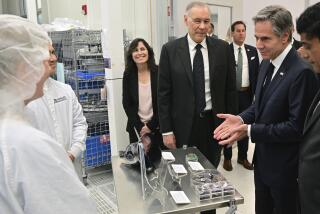HP Wins Research Grant
- Share via
PALO ALTO — Hewlett-Packard Co. won another U.S. government grant for research into using chemical reactions to build molecular computer chips, a method that would overhaul chip manufacturing.
The second-biggest computer maker got a $12.5 million, four- year grant from the Defense Advanced Research Projects Agency, and the company will add $13.2 million of its own funds. DARPA already had given Hewlett-Packard $4 million for two years.
Present manufacturing techniques could become obsolete in 10 years, analysts say, as the chip industry improves production methods and shrinks circuit sizes. This research may provide an alternative. HP Labs is creating transistors and switches it hopes will make up the chips of the future--storing more data, using less power and costing less to make.
Manufacturers use complex tools to print designs, etch wires and scrape away extra material from the layers of metals and insulators that chips comprise. A fully equipped factory costs at least $2 billion to build.
The HP Labs team discovered how to use chemical processes to grow wires on silicon, press the device against a bath of liquid to apply switches and then lay the next set of wires to complete the circuit.
This method, which is years from commercial production use, needn’t be as pristine as today’s super-clean chip factories. That could cut production costs significantly. Present chips can be ruined by a speck of dust during production.
“Our goal is to make chips so cheaply and easily that any 12-year-old with a chemistry set could do it,” Stan Williams, who runs the team, has said of the project.
The group met DARPA’s original challenge of crafting a working 16-bit memory device by this month or next. That’s about as complex as a chip from the 1970s. Now there’s a new mission: to create a 16,000-bit part by June 2005.
To do that, researchers must improve the wires they’re building and the connections between those molecular wires and the standard ones that hook up to real-world devices. With a 16-bit part, the wires could be connected by hand, one by one. With the larger goal come hundreds more wires, and the team is developing techniques to automate making the connections.






